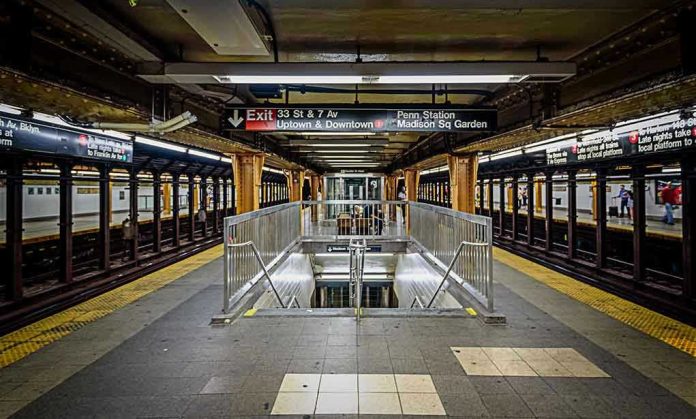
Six young suspects wielding knives in a NYC subway robbery spotlight persistent urban crime and highlight ongoing risks to law-abiding citizens, as recent data reveals violent assaults remain a threat despite claims of improvement.
Story Snapshot
- Six “pint-sized” perpetrators arrested for violent knifepoint robbery in NYC subway, raising alarm about youth crime trends.
- Despite claims of improved safety, felony assaults in the subway have increased since 2019, challenging official optimism.
- Enhanced patrols and surveillance have yielded record lows in certain major felonies, but concerns about violence persist.
- Persistent crime impacts riders’ safety, local businesses, and public trust—spurring calls for robust law enforcement and policy changes.
Violent Youth Crime Shakes NYC Subway Riders
Six juveniles described as “pint-sized perps” were arrested after a brazen knifepoint robbery in a New York City subway station. The incident comes as violent crime remains a top concern for many commuters, who have long viewed the subway as increasingly unsafe. Though exact details of the timeline are limited, this case fits a troubling pattern where youthful offenders employ severe tactics, raising questions about accountability and the effectiveness of current safety policies. The involvement of such young suspects in a serious crime amplifies calls for strong enforcement and renewed scrutiny of lenient approaches to juvenile justice.
Crime Rates: Mixed Signals Amid Official Optimism
Recent MTA reports tout July 2025 as the safest July ever for the NYC subway, citing an 8% drop in major felonies compared to the previous year. These figures reflect increased police presence and expanded surveillance, which have contributed to a reduction in some categories like robberies and grand larcenies. However, deeper analysis of crime statistics reveals a persistent—and in some cases rising—problem with violent assaults, including felony attacks that have increased since 2019. This contradiction in crime trends has left many New Yorkers skeptical of official narratives and concerned about their daily safety on public transit.
Stakeholders and the Push for Security
The NYPD and Metropolitan Transportation Authority (MTA) are the primary forces tasked with policing and securing the subway system. Their efforts include more patrols, upgraded security cameras, and coordinated safety initiatives. The city government influences funding and policy, often balancing safety needs against budget constraints. Despite these measures, the frequency of violent incidents continues to disrupt commuters and deter tourists, with businesses also feeling the economic pinch. The ongoing situation has made subway safety a flashpoint in debates over law enforcement, public spending priorities, and the proper balance between civil liberties and public security.
Broader Impact: Economic, Social, and Political Costs
Persistent subway crime undermines confidence in New York’s transit system and affects a wide swath of the population. Riders are forced to adjust travel routines out of fear, while businesses lose customers wary of unsafe commutes. The city’s reputation as a global hub is at risk if crime is not addressed with common-sense policies and decisive action. Politically, public frustration with rising violence has fueled support for stronger policing and policy reforms, with many calling for an end to what they see as government overreach and ineffective social agendas. The stakes extend beyond New York, as other cities watch and learn from the outcomes of NYC’s safety strategies.
Expert Views: Enforcement vs. Root Causes
Security experts and academics agree that solving subway crime requires a multifaceted approach. Increased patrols and surveillance have shown effectiveness in curbing some felonies, but experts caution that deeper socioeconomic factors—such as poverty and family breakdown—must also be addressed. Some argue that crime data can be misleading due to changes in reporting or classification, while others insist that only robust enforcement and community engagement can restore order. For now, the consensus is clear: New Yorkers demand safety, accountability, and policies that put law-abiding citizens first.
Sources:
The State of Crime in New York City at Midyear 2025
MTA Announces Last Month Was Safest July in NYC Subway History
FTA Senior Advisor Marc Molinaro: Crime in Subway is Real
NYPD Record-Low Shooting Incidents and Victims: First Nine Months of the Year
Safer Subways: Governor Hochul Announces Subway Crime Fell to Historic Lows This Summer
NYPD Record-Low Shooting Incidents and Victims: First Eight Months of the Year







